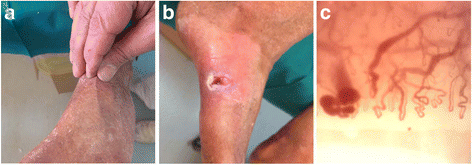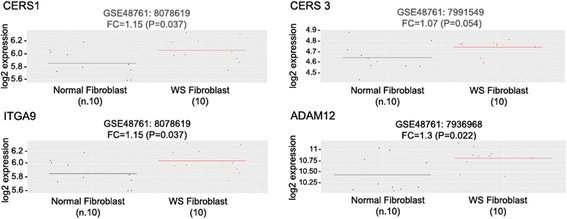Genome-wide DNA methylation analysis in blood cells from patients with Werner syndrome
- PMID: 28861129
- PMCID: PMC5577832
- DOI: 10.1186/s13148-017-0389-4
Genome-wide DNA methylation analysis in blood cells from patients with Werner syndrome
Abstract
Background: Werner syndrome is a progeroid disorder characterized by premature age-related phenotypes. Although it is well established that autosomal recessive mutations in the WRN gene is responsible for Werner syndrome, the molecular alterations that lead to disease phenotype remain still unidentified.
Results: To address whether epigenetic changes can be associated with Werner syndrome phenotype, we analysed genome-wide DNA methylation profile using the Infinium MethylationEPIC BeadChip in the whole blood from three patients affected by Werner syndrome compared with three age- and sex-matched healthy controls. Hypermethylated probes were enriched in glycosphingolipid biosynthesis, FoxO signalling and insulin signalling pathways, while hypomethylated probes were enriched in PI3K-Akt signalling and focal adhesion pathways. Twenty-two out of 47 of the differentially methylated genes belonging to the enriched pathways resulted differentially expressed in a publicly available dataset on Werner syndrome fibroblasts. Interestingly, differentially methylated regions identified CERS1 and CERS3, two members of the ceramide synthase family. Moreover, we found differentially methylated probes within ITGA9 and ADAM12 genes, whose methylation is altered in systemic sclerosis, and within the PRDM8 gene, whose methylation is affected in dyskeratosis congenita and Down syndrome.
Conclusions: DNA methylation changes in the peripheral blood from Werner syndrome patients provide new insight in the pathogenesis of the disease, highlighting in some cases a functional correlation of gene expression and methylation status.
Keywords: DNA methylation; Systemic sclerosis; Werner syndrome.
Conflict of interest statement
Ethics approval and consent to participate
Subjects were enrolled in the study “Early diagnosis of scleroderma and identification of predictor factors of disease development”. All participants signed the informed consent forms. The study was approved by the Ethic Committee of ASL RM/B, Prot.054/CE-RMB.
Consent for publication
Consent for publication was obtained from the patient.
Competing interests
The authors declare that they have no competing interests.
Publisher’s Note
Springer Nature remains neutral with regard to jurisdictional claims in published maps and institutional affiliations.
Figures



Similar articles
-
Epigenetic signatures of Werner syndrome occur early in life and are distinct from normal epigenetic aging processes.Aging Cell. 2019 Oct;18(5):e12995. doi: 10.1111/acel.12995. Epub 2019 Jul 1. Aging Cell. 2019. PMID: 31259468 Free PMC article.
-
Genome-Wide DNA Methylation and Gene Expression in Patients with Indolent Systemic Mastocytosis.Int J Mol Sci. 2023 Sep 10;24(18):13910. doi: 10.3390/ijms241813910. Int J Mol Sci. 2023. PMID: 37762215 Free PMC article.
-
DNA methylation signatures in Blood DNA of Hutchinson-Gilford Progeria syndrome.Aging Cell. 2022 Feb;21(2):e13555. doi: 10.1111/acel.13555. Epub 2022 Jan 19. Aging Cell. 2022. PMID: 35045206 Free PMC article.
-
Deficient DNA repair in the human progeroid disorder, Werner syndrome.Mutat Res. 2005 Sep 4;577(1-2):252-9. doi: 10.1016/j.mrfmmm.2005.03.021. Mutat Res. 2005. PMID: 15916783 Review.
-
'Werner Syndrome foot'-A case series of four Irish Traveller siblings with Werner Syndrome, diabetes mellitus and complex foot disease.Diabet Med. 2024 Sep;41(9):e15390. doi: 10.1111/dme.15390. Epub 2024 Jun 24. Diabet Med. 2024. PMID: 38924167 Review.
Cited by
-
Fail-tests of DNA methylation clocks, and development of a noise barometer for measuring epigenetic pressure of aging and disease.Aging (Albany NY). 2023 Sep 12;15(17):8552-8575. doi: 10.18632/aging.205046. Epub 2023 Sep 12. Aging (Albany NY). 2023. PMID: 37702598 Free PMC article.
-
The Continuum of Aging and Age-Related Diseases: Common Mechanisms but Different Rates.Front Med (Lausanne). 2018 Mar 12;5:61. doi: 10.3389/fmed.2018.00061. eCollection 2018. Front Med (Lausanne). 2018. PMID: 29662881 Free PMC article. Review.
-
The Potential Role of CERS1 in Autophagy Through PI3K/AKT Signaling Pathway in Hypophysoma.Technol Cancer Res Treat. 2020 Jan-Dec;19:1533033820977536. doi: 10.1177/1533033820977536. Technol Cancer Res Treat. 2020. PMID: 33267708 Free PMC article.
-
Vitamin D and the promoter methylation of its metabolic pathway genes in association with the risk and prognosis of tuberculosis.Clin Epigenetics. 2018 Sep 12;10(1):118. doi: 10.1186/s13148-018-0552-6. Clin Epigenetics. 2018. PMID: 30208925 Free PMC article.
-
MADA: a web service for analysing DNA methylation array data.BMC Bioinformatics. 2020 Nov 18;21(Suppl 6):403. doi: 10.1186/s12859-020-03734-9. BMC Bioinformatics. 2020. PMID: 33203349 Free PMC article.
References
MeSH terms
Substances
LinkOut - more resources
Full Text Sources
Other Literature Sources
Molecular Biology Databases
Miscellaneous

